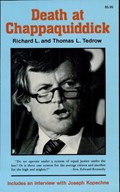I still feel a lot of bitterness. It's been a long time, but to me it was just yesterday. I'll never forgive him. I don't believe the truth has been told. I don't know the truth. None of us knows the truth. It's still a mystery . . . . There was just too much deception, too much double talk and cover up. -- Joseph Kopechne, Women's News Service
This then is the real horror of the case. Mary Jo in the bottom of that upside-down car, wedged in, clawing, clutching and straining for air and for life in the total blackness at the bottom of Poucha Pond with water creeping higher and higher. Completely terrified, she waited for help from Senator Kennedy - who was on the phone seeking help not for Mary Jo, but for Senator Kennedy.
From Death at Chappaquiddick
On July 19, 1969, Senator Edward Kennedy drove off a bridge on Chappaquiddick Island, leading to the death of his young female companion and, the authors contend, an extensive cover up to protect Kennedy's political ambitions. The Tedrow recreates the unexplained events of that fateful night, examine the self-admitted panic of a U. S. senator, and point by point puncture Kennedy's sieve-like account of the tragedy. The authors' exhaustive investigation produces solid answers to curious questions. Most damning of all, they present evidence that Kennedy fled the scene in panic, then spent hours telephoning cronies seeking political protection while a helpless Mary Jo Kapechne slowly suffocated in a pocket of air inside the submerged auto. Richard L. Tedrow served for 17 years as Chief Commissioner of the U. S. Court of Military Appeal and is the author of the standard reference for U. S. military court martials. Thomas Tedrow is a freelance writer in Houston, Texas.

